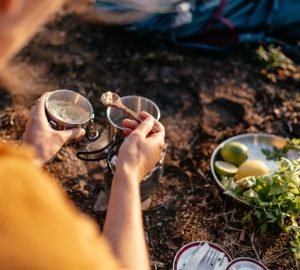Eating on longer trekking tours is not such a simple issue: If you want to provide for yourself for several days or even weeks and hike every day, you need quite a lot of provisions. Fresh food is only suitable for the first few days. After that, you need trekking food.
You need a lot of energy for trekking. If you can’t buy food or stop for a snack along the way, you’ll have to bring everything you need to replenish your energy reserves. Food planning can be tricky, though. On the one hand, you don’t want to go hungry – on the other hand, you don’t want to carry around unnecessary weight.
Plan your meals as precisely as possible before the tour
It’s best to plan in portions and pack your food in these units. This will give you the best overview of the calories you plan to eat each day and help you estimate how heavy your provisions will be.
A calorie calculator (can be found on the Internet) will help you estimate how much you will consume. In the beginning you will probably take too much with you and have to carry a few unnecessary kilos. However, this is better than running out of food on the road.
Roughly speaking, you can assume that men consume between 3,000 and 5,000 calories per day when hiking, depending on their body weight, metabolism and temperature, while women consume somewhat fewer. That is not so little and must first be covered.

Cookware by Tatonka made of stainless steel for your next camping or trekking trip.
What trekking food is all about: Nutritional value and shelf life
Carbohydrates are the most important source of energy for the work of the body and brain and are therefore particularly important on trekking tours: the optimum ratio is 60/20/20 (carbohydrates, proteins, fat).
Meals that correspond exactly to this ratio are now available ready to buy from some outdoor manufacturers. These are freeze-dried mixtures consisting of pasta, mashed potatoes or rice and other ingredients. Is this type of outdoor nutrition recommendable?
Special trekking food: advantages and disadvantages
Freeze-dried outdoor food comes in all sorts of flavors, packaged in portions. You only need to add hot water for preparation. Then it’s straight to feasting. This kind of trekking food is probably the easiest way to get full after a long day’s hike.
However, ready-made outdoor food, such as that developed for extreme expeditions, is quite expensive. You have to reckon with four to ten euros per portion. That adds up to a lot on a longer tour. And the packaging waste that results is not exactly small.
For the weight of your trekking backpack, on the other hand, the ready-made portions are a relief. The packets themselves contain virtually no liquid. This makes them very light. In addition, you hardly need any accessories. Most of the time, you can pour the hot water directly into the pack. So you need to carry relatively little cookware. You also need relatively little fuel for heating.

Ready-made products from the supermarket
Ready-made meals from the supermarket are cheaper than special trekking food from the outdoor store. Here, too, you’ll find whole shelves full of dishes that require nothing more than hot water to prepare. In the case of pasta with tomato sauce, for example, there shouldn’t be much difference here from the products of expedition food manufacturers – except for the price.
However, it is important to look at the nutrition table: How many calories per 100 grams does the dish have and what is its composition? There are considerable differences here between individual packages.

Also interesting: Trekking tips – The 5 most common beginner’s mistakes and how to avoid them
Bars for the trekking tour
Bars are extremely practical on trekking tours. They fill you up, are light, compact and durable. High-quality cereal bars have the best nutritional value. However, it is advisable to pack different varieties. Otherwise, you’ll be sick of the cereal bars after a few days.
Don’t be afraid to pack candy bars, too. They won’t fill you up for as long, but they’ll give you quick energy and lift your spirits if you’re in a slump.
By the way, you can also make muesli bars yourself quite easily: You need muesli, oat flakes and flour as well as nuts and dried fruits of your choice. Once you have chopped the nuts and fruit, mix everything with honey and a little water. Spread the mixture evenly on a baking tray and put it in the oven. You can find numerous recipes with exact quantities on many Internet portals.
By the way, nuts and dried fruits are not only in bar form an optimal energy supplier for on the go.
Reading tip: Trekking Guide – Everything you need to know
Food for a day of trekking – an example:
The best breakfast is oatmeal with milk powder and water or porridge in cold temperatures. With this you start well strengthened into a strenuous day. Your meal plan for the day could look something like this:
- Porridge or oatmeal with milk powder
- Nuts
- Dried fruits
- Muesli bar
- Chocolate bar
- Spelt crackers
- Vegetable broth cubes in hot water
- Pemmican or beef jerky (dried meat)
- 1 package of trekking food or self-dried food
Making trekking food yourself – is it possible?
Making trekking food yourself is not that difficult. Basically, it’s a matter of removing the water from the food. This is because water makes up most of the weight and causes food to spoil more quickly. This works with fruits, vegetables, but also with eggs, meat and cheese.
Drying is the keyword here. This involves drying food at a low temperature (50 to 70 degrees Celsius) over a period of several hours. The best way to do this is in an automatic dehydrator. For those who often go trekking, the purchase of such a device is definitely worthwhile. A reasonable dehydrator is available for as little as 50 euros.
You can also dehydrate food in the oven, if you leave the oven door ajar with circulating air, so that the moisture can escape. However, this is quite a waste of energy.
Instructions for drying different foods with exact temperature and time specifications can be found online.
Good to know: Safety on the Mountain – Getting emergency help in the mountains
With these tips, you should be able to eat well on your next trekking trip. But don’t forget to try the meals you take with you at least once at home before you set off. Because a meal can have as many nutrients as you want – if you don’t like it, it won’t help. After all, at the end of a long day, outdoor love also goes through the stomach.







